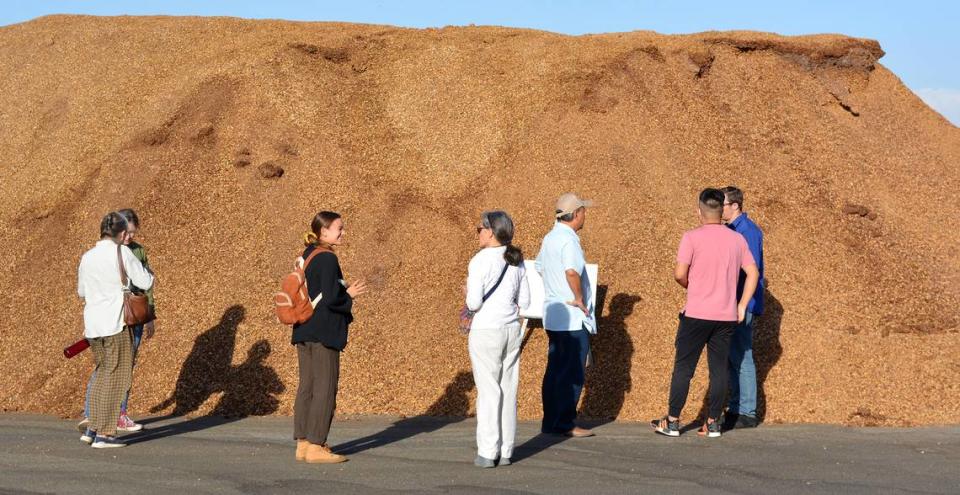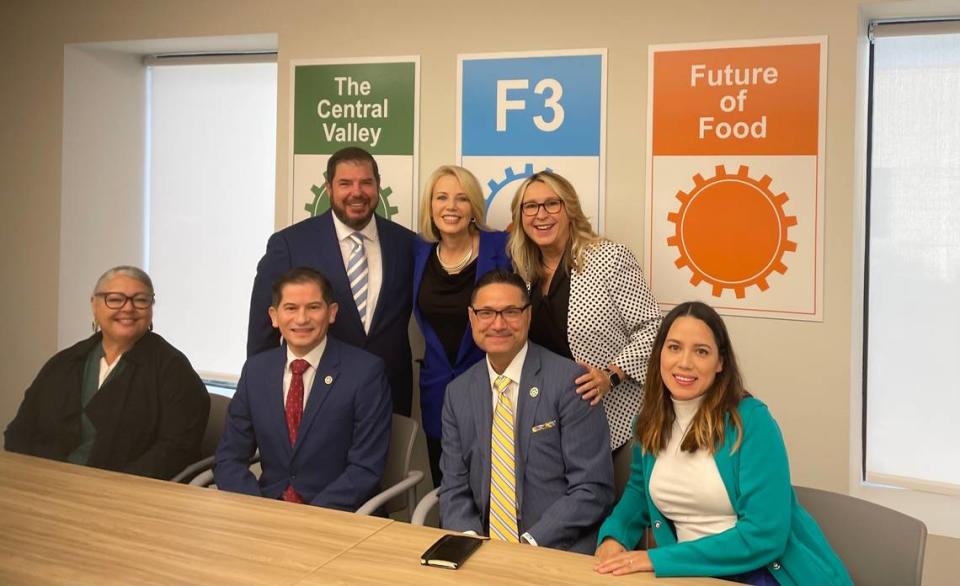Collaboration or competition? How Valley counties work on jobs, housing, other issues
With high-speed rail launching and better Amtrak service on the way, promising better access to the San Joaquin Valley from the coast and other regions, there perhaps never has been a better time for regional leaders to band together to sell the positives. Under such a united economic development approach, a win for Modesto would count as a win for Fresno, Merced and others in the region. That rising tide would help all the region’s boats, the theory goes.
The Valley already has many collaborative efforts. The Fresno-Merced Future of Food Initiative seeks to get farmworkers into higher-tech jobs in that industry. The Stanislaus 2030 plan for bio-based materials and fuels also takes in San Joaquin and Merced counties.
Two large efforts underway intend to attract some of the $600 million available from the California Jobs First program, formerly called the Community Economic Resilience Fund, or CERF.
The state is awarding funds to 13 regions, some of them containing several counties. Merced, Stanislaus and San Joaquin counties are working as the North San Joaquin Valley coalition, or North Valley Thrive, whose mission is to “implement transparent and community-centered processes for inclusive economic development planning that will advance long-term prosperity and equity across the Northern San Joaquin Valley.”
Below it on the map is the Central San Joaquin Valley coalition, which includes Fresno, Madera, Tulare and Kings counties. It says its Regional Economic Recovery and Transition Plan “will include strategies for the growth of targeted industries, diversifying the economy, responding to economic shocks, increasing economic equity, and increasing health and environmental equity.”
Who’s guiding San Joaquin Valley economic development, and how? Join the conversation
“We collaborate actually with a ton of partners in the Central Valley,” said Lance Lippincott, city of Fresno economic development director.
In Chowchilla, the second annual Central Valley Economic Summit on Nov. 2 — organized by the city’s economic development department — attracted representation from Merced, Fresno, Madera, Kings and Stanislaus counties.
The region is expanding the Amtrak San Joaquins rail line, serving all of the counties, and the Altamont Corridor Express in the northern portion. And UC Merced has wide support for adding a medical school focused on residents’ health.
Stanislaus County Chief Executive Officer Jody Hayes told The Modesto Bee via email in August, “We have (a) close relationship with all counties in the Valley and often work together to represent our interests in Sacramento.”
Modesto Mayor Sue Zwahlen noted challenges with housing costs but said the Valley overall is working hard.
“We’re all vying for dollars, and it takes money to make improvements,” she said in an August conversation with The Bee. “We need those voices in Sacramento, and I feel that’s happening. Our state officials are connecting with us more than they ever have.”
Goals on jobs, equity and carbon
Christy Patch, director of collective impact for the Central Valley Community Foundation, said California Jobs First has three prongs: creating good jobs, making sure those opportunities are centered on equity, and support for carbon neutrality.
The foundation is the regional convener for the Central San Joaquin Valley coalition, which includes more than 100 partners representing sectors like education, the workforce and local government.
The bigger picture for the coalition, Patch said, is creating strong, viable projects that can be shopped to federal and other state funding sources. Right now, the coalition is in the community engagement phase with industries, residents and other stakeholders.
What Patch has not been surprised by what she’s heard stakeholders say they need: education, water, housing, health care.
“You can look at any of those areas and see both resources and areas for growth,” she said.
Building boats in Chowchilla
To Patch, one of the Valley’s greatest assets is the youth of its workforce.
That will be key for people like David Telling, 78, who co-owns Flight Craft Boats with his business partner, Miguel Magaña.
They opened their boat-building business in Chowchilla three years ago because of the city’s land availability. The employment pool in the Valley is good, as a large number of experienced builders live within driving distance, Telling said.
“But they’re aging,” he said. “It would be good to have training for this type of work at junior colleges.”
To Patch, pairing the region’s youthful workforce with its potential to expand access to affordable education would help maximize the possibilities in the Valley.
Mike Dozier, former economic development director for the city of Clovis, said collaborations should also include the K-12 educational system.
“That’s a big deal for any employer for a lot of different reasons,” he said, noting that it benefits the workforce and the area as a place to live.
Basic needs include water and sewer
Basic infrastructure, such as water and sewer lines, is another challenge the Valley faces, said Mark Hamilton, economic development director for the city of Chowchilla. The director for Tulare County’s Economic Development Office, Mike Washam, said the same.
“In our unincorporated areas, sewer and water are not necessarily available,” Washam said, adding that wells must often be drilled and wastewater treated on site.
Lippincott, the Fresno economic development director, said he learned of another Valley challenge from his experiences at trade shows with international companies. “Either (the Central Valley is) not well known, or what’s known about it isn’t entirely correct,” he said, noting that the region’s economy has diversified while remaining strong in agricultural production.
Bernadette Rojas, Central Valley and coastal California director for the U.S. Commercial Service, said she’s marketed the region as the “gateway to Yosemite” in presentations to those who may have heard of Fresno only in movies.
That description elicits the response, ‘Oh, yes, we know Yosemite,’” Rojas said.
Several local economic development directors said one of the Valley’s biggest assets is available land – at a relatively affordable price.
It’s also “location, location, location,” Washam said.
Tulare County, he noted, is strategically located between the ports of Los Angeles and Oakland. As the logistics and transport industries in the Inland Empire near the point where they’ve built out, the Central Valley has started attracting those businesses, Washam added.
Collaboration ‘a catalyst’ for future work
Regional collaboration for economic development in the Valley is not a new thing, Dozier said. In the past, he also worked as the director for Fresno State’s Office of Community and Economic Development and for the California Partnership for the San Joaquin Valley.
The California Central Valley Economic Development Corp. has met monthly for years. Representatives from eight counties talk about project leads and trade shows.
“While they were in competition with each other, they’d rather see whatever they lost come into the Valley than go someplace else,” Dozier said.
But to Dozier, collaboration is a tricky deal. The benefits of it are not apparent in “one big swoop.” Instead, it’s a catalyst for working together with the right people when big opportunities come later down the road.
One of those big opportunities is the California Jobs First funding that Valley counties are working together for.
“We want to make sure that we’re really capitalizing on keeping that value chain local and making sure that our community and our residents are seeing the benefits of some of those new projects that are going to be coming to our area,” Patch said.
Looking to export markets
Some federal efforts could help homegrown businesses see those benefits through attracting foreign markets and selling the Valley as a region.
Rojas, of the U.S. Commercial Service, said the Valley has a great ability to do that right now. The majority of the clients the agency helps to increase their exports are small and medium-size businesses, Rojas said.
She said she’s been encouraging local economic development organizations to apply for spin-off events that happen before or after the service’s annual SelectUSA Investment Summit. Foreign investors attend the spin-off events, during which regions can spotlight the economic benefits they have to offer.
“It’s better to come together,” Rojas said. “What are your strengths? Identify those for each of those (economic development organizations) that want to get together, see which sets one apart from the other so that you could advertise and market those strengths — in this county you have ‘x’ and in another you have ‘y’ — so that it’s not seeming as if you’re competing, but offering huge complementary strengths.”


